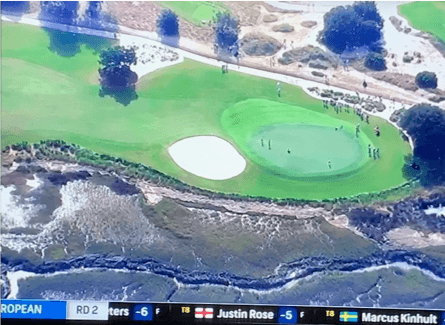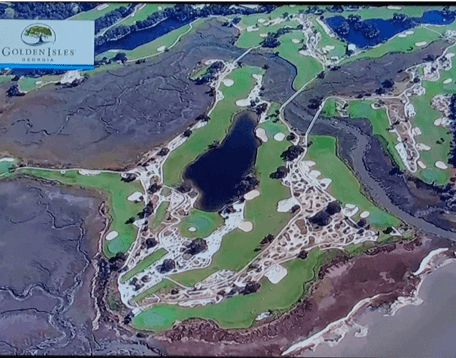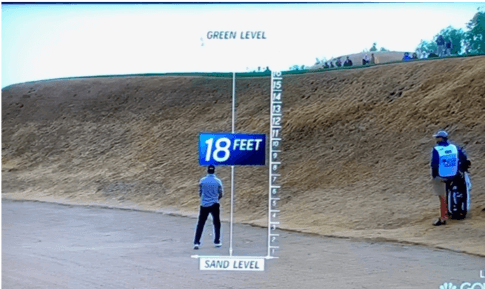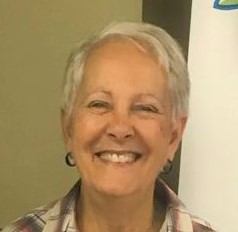No, not the internet links … golf! Yup. Golf links.
I love watching golf because my family often watched on a Sunday afternoon if the weather wasn’t conducive where we lived for my folks — who loved playing — to play. I tried playing for a few years, but didn’t enjoy actually it, although I came to love watching others.
Because of time constraints, I always save programs on my DVR, which allows me to both fast-forward to skip commercials and to pause the show for something interesting.

Recently I was watching the first day of the RMS Classic, and I saw how differently the greens were colored (on the TV screen, the bluish area in the picture above was much grayer) from the surrounding terrain, and then I remembered I’d taken a few pictures previously showing some other physical features at a different tournament that amazed me.
Suddenly I saw the connections between those pictures and the lessons they can teach us.
1. Perspective #1: It can change depending on where you’re standing. Folks on golf courses see their surroundings from their ground view — looking ahead shows the level of the ground, but it may not show some of the treacherous details, especially if they’re lower than the ground level.

This picture on the left was taken from a drone (or a blimp) and shows clearly what a human standing on the ground wouldn’t see as clearly. Knowing there’s water in so many places and how steep the sides are is very different from seeing those things, right?
Having a bird’s-eye view certainly makes our choices clearer, knowing just how close the dangers are.
Lesson: The virtues of diversity are many, and the top one has to be the differing perspectives we can learn from. No one person knows everything; it truly does take a village mindset to learn what others know or believe that is different from our knowledge or thoughts. We need to find others who are smart in areas we’re not and join forces. What do they see that we’re blind to? What options do they offer based on their knowledge, their perspective? What haven’t we even considered? What then makes sense for us to do?

2. Perspective #2: Knowing it or actually living it.
All golf courses have bunkers / sand traps, which can catch a golfer’s ball and make it extremely difficult to get it out of the trap. But few courses have bunkers that are 18’ deep, which is a whole other challenge!
And pro golfers certainly scout out the landscape of any course they’re going to play on; they don’t just show up and say “Oh, gee! Look at that!” But knowing it and seeing are two very different things, especially something like this.
I watched in awe as that golfer above lifted his golf ball up over the 18’-height, and dropped it within a couple of feet of the hole’s location that he couldn’t even see from down below. Of course, he had walked up several times and seen where the hole was; he was aware of how far he had to hit it. But still … it was amazing!

Sad to say, I think the golfer at the left didn’t get his ball over the edge on the first try.
Lesson: Life has challenges, and we cannot know for certain what we’ll be faced with. But we can at least consider what could lie ahead — the good, the bad, and the ugly — and scout out the information or at least consider how we might cope.
Are there articles somewhere on the topic? Pictures? Experts to call on? Friends or colleagues or even competitors who have faced challenges we might encounter? What can we learn before we need to know it?
Harvey Mackay: “Dig your well before you’re thirsty.”
USA Scouts: “Be prepared.”
Stephen Covey: “Begin with the end in mind.”
3. Focus: Where is yours?
PGA tournaments are usually for four consecutive days (weather permitting), and everyone plays at least the first two days; those who “make the cut” (score well enough) then play the third and fourth days to win prize money.
They are competitors, of course, but they are also colleagues. They all have a bag of up to 14 clubs, although they may be different ones. They all have a caddie who carries the heavy bag and offers advice and another perspective on upcoming shots (and sometimes solace after a bad shot). They play the same course(s), but hit different shots, even in the same basic conditions, because each comes with different a skillset.
Player A may be excellent at hitting that all-important first shot, and getting the ball in position to score a great low number. Player B may be a far better putter, rarely missing anything within 10 feet. Player C might be better in the wind due to hitting low bullet-type shots; Player D might land the ball more softly because of the high arc the shots take. So each player has to figure out how to maximize what he or she does best, and learn to do those types of shots that challenge them at least a little better.
They are competitors, but the person they’re really competing against with every shot is … themselves. They have no control over anyone else’s choices or shots or luck or results. Good and bad breaks just happen. Heck, even with their BEST efforts and results, they may not win that particular tournament because some else made one better shot or got one more good break.
Lesson: While we can (and probably should) consider how and what our competition is doing, we really can only take care of our own abilities, skills, needs, etc. We can see others as worthy of emulating, worthy of competing against, but in the end, it’s how we play that we have control over. And no one wins it all every time.
We need to constantly assess where WE are and how WE are doing, knowing that it’ll be OUR efforts that will make the most difference in how we both play the game and get the results we’re seeking.
What might you add to this? I value your thoughts!

